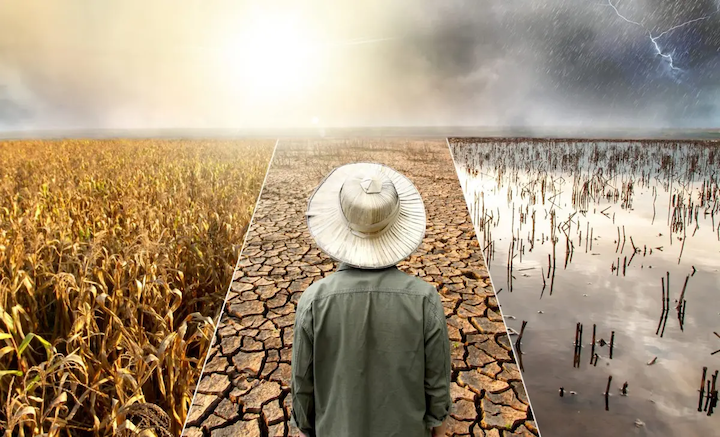The year ignited with a series of 31 wildfires across the Los Angeles metropolitan area and surrounding regions. Exacerbated by drought conditions, low humidity and wind: 28 people are dead; 205,000 have been evacuated; and more than 17,711 structures are damaged or destroyed.
Three days prior to the Pacific Palisades fire igniting, Daniel Swain, a climate scientist at U.C.L.A., posted a warning on his blog, Weather West: "A prolonged, and possibly extreme offshore wind and fire weather event to unfold this week across SoCal.” Hydroclimate Volatility on a Warming Earth tries to explain the science behind increasingly dramatic swings between wet and dry periods all around the world. In shorthand Swain warned: "There is a huge fire coming toward you very fast. Leave now.”
After years of severe drought, dozens of atmospheric rivers deluged California with record-breaking precipitation in the winter of 2022-23, burying mountain towns in snow, flooding valleys with rain, and subsequently setting the stage for landslides. 2024 followed with a record hot summer and record-dry fall tendering tinder-dry vegetation + Santa Ana winds which resulted in the Southern California wildfires of 2025.
Hydroclimate Whiplash — a rapid swing between intensely wet and dangerously dry weather — has increased by 66 percent globally since 1950, and has recently been speeding up. According to NOAA's 2023 Annual Climate Report the combined land and ocean temperature has increased at an average rate of 0.11° Fahrenheit (0.06° Celsius) per decade since 1850, or about 2° F in total. The rate of warming since 1982 is more than three times as fast: 0.36° F (0.20° C) per decade. Global temperature is projected to warm by about 1.5 degrees Celsius (2.7° degrees Fahrenheit) by 2050 and 2-4 degrees Celsius (3.6-7.2 degrees Fahrenheit) by 2100.
The real culprit of Whiplash events is the Atmospheric Sponge: a warmer atmosphere can suck up more water from soil and plants; a warmer atmosphere can hold more water vapor; and a warmer atmosphere can produce sudden torrential downpours that trigger floods, power outages, landslides. Poor drainage destroys crops, overtakes sewers and spreads disease.
Whiplash is the universal signature of climate change.
In 2024, there were 27 confirmed weather/climate disaster events in the United States, including: droughts, floods, severe storms, tropical cyclones, hurricanes and a wildfire. Some 568 people were killed, and the combined events caused $182.7 billion in damages, according to the National Centers for Environmental Information.
Floods in Afghanistan, Enga Landslides, Typhoon Yagi, and Hurricane Helene were global climate disasters in 2024. Extreme weather events have cost the global economy more than $2 trillion over the past decade, according to the ICC. In "Only One Earth" Barbara Ward observes, "We have forgotten how to be good guests, how to walk lightly on the earth as its other creatures do."
Franz Kafka, a luminous 20th century literary figure, took on the affects of the Second Industrial Revolution. The Metamorphosis follows an everyday hardworking father and husband, who wakes one morning to find himself transformed into an insect. The sudden metamorphosis challenges him to adapt to an environment that's no longer practical, relevant, or really even inhabitable. Kafka writes:
The animal wrests the whip from its master and whips itself in order to become master, not knowing that this is only a fantasy produced by a new knot in the master's whiplash.
Science confirms that a range of sectors and processes contribute to global emissions. There is no single or simple solution to climate change. Focusing on electricity, transport, food, or deforestation alone is insufficient.
Even within the energy sector — which accounts for almost three-quarters of greenhouse emissions — there is no simple fix. According to the EPA, the transportation sector is the source of 29 percent of greenhouse gas emissions in the US; The Industrial sector emits 30 percent of the greenhouse gas emissions; and finally the Commercial and Residential sector’s burning of fossil fuels to heat and cool their commercial buildings and residential homes comes in at 31 percent.
Nearly 1 billion people are energy poor and don't have electricity, according to the IEA, rendering the remaining 7 billion people around the world complicit in one form or other of burning fossil fuels and producing green house emissions.
In other news, an arctic air mass sprawling across the eastern, central and western U.S. has suddenly dipped and without warning dropped the average temperatures 20-30 degrees below normal. The unprecedented snow and ice in Houston and New Orleans produced an unprecedented flurry of snow days, sledding excursions, and recreational activity whilst simultaneously causing at least 9 casualties; hundreds of automobile accidents; and thousands of flight cancellations. By and by, the newly christened ‘Gulf of America’ will proffer a reply. For Kafka, man has already crystalized from a catalyst to a cocktail party joke of the Industrial Complex.
Archives










